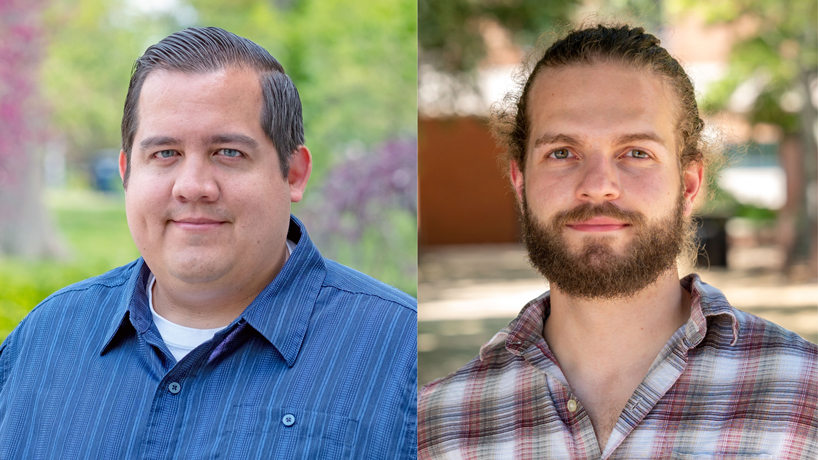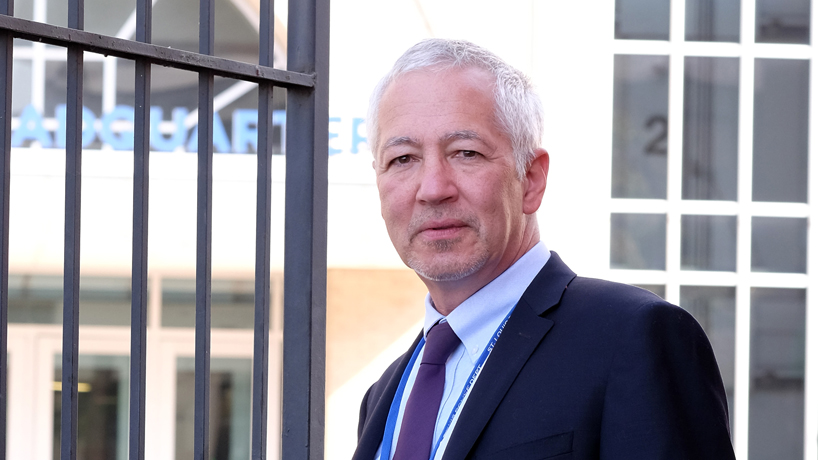
Criminology and criminal justice doctoral candidates Ernesto Lopez (at left) and Bobby Boxerman compiled research on crime in 29 large U.S. cities in the first six months of 2022 for a new report they co-authored with Curators’ Distinguished Professor Emeritus Richard Rosenfeld for the Council on Criminal Justice. (Photos by August Jennewein)
The latest Council on Criminal Justice report from University of Missouri–St. Louis Curators’ Distinguished Professor Emeritus Richard Rosenfeld on the state crime in the first half of 2022 again generated national headlines over the past two weeks.
“U.S. killings still much higher than before the pandemic, report says,” read The Washington Post.
“A Drop in Murders: Despite the grim headlines, 2022 is less violent so far than last year,” read The New York Times.
There continues to be interest in the ongoing study Rosenfeld has been leading for the Washington-based think tank since the summer of 2020.
But Rosenfeld is the first to note that the report – the ninth in the series on “Pandemic, Social Unrest, and Crime in U.S. Cities” – would not have been possible without the contributions of UMSL criminology and criminal justice doctoral candidates Ernesto Lopez and Bobby Boxerman, with whom he shared a byline.
Curators’ Distinguished Professor Emeritus Richard Rosenfeld has been leading the ongoing study of crime in large American cities during the COVID-19 pandemic since the summer of 2020.
“I think the value is incalculable – it really is,” Rosenfeld said of the contributions of the two students. “The collaboration, the collegiality that Ernesto and now Bobby have provided has just been terrific. Needless to say, I wouldn’t be able to prepare these reports without the work that they do. Their work is absolutely essential. They know the data that we use, inside and out. They have a much more detailed sense of the data than I do. So I rely on their good judgment and their commitment to the project, and both have just been terrific. I can’t speak highly enough about them.”
Lopez has been working with Rosenfeld since the project began, and his involvement even helped him land a full-time position last year as a research specialist for the Council on Criminal Justice.
He was on paternity leave with the birth of his second child last month, so he pulled in Boxerman to help with the compiling data for the most recent report.
They’ve worked with a list of cities with populations of at least 250,000 people, and they’ve gone to police department and city government websites in those cities to collect publicly available incident-level data updated at regular intervals – in some cases weekly but more recently monthly.
They gather the data together to get an overview of those cities – 29 in the most recent report – as a representation of national trends.
“It’s been really cool,” said Boxerman, who previously has assisted Professor Lee Slocum with research on probation and early release programs and has also been studying incidents of assaults involving firearms. “You get to see sides of the project that you don’t normally see. I think the most interesting thing to me is how it’s really as simple as it seems. Obviously, it can be complicated verifying the data and doing some checks and whatnot, but it’s interesting to take the individual police departments or city data – wherever we might get it from – and see that these are real things happening from real cities and real people.
“It’s easy to see the report and not really make that connection. But looking at the data from every city and assembling it the way I did kind of reinforces that like – that this is very real. And that’s it’s interesting and exciting to me.”
Boxerman put together the data over several days in early July and shared it with Rosenfeld. He compared the numbers to previous intervals and began preparing a report with key takeaways.
The homicide numbers – which dipped slightly compared to the same time period in 2021 – always gather the most attention from news outlets, but the report examines monthly crime rates for 10 violent, property, and drug offenses. It showed property crimes, particularly larceny, on the rise.
Lopez, who has been observing shifts in the trends over the past two years, has found himself most intrigued by the continuing rise in motor vehicle thefts.
“Some of the data does match pretty well with homicide when you look month by month by cities,” he said. “But the homicide trend, as we’ve noted, is going downward while motor vehicle theft is continuing to increase. It’d be interesting to see if that continues for another half year. That’s something I think deserves a little more investigation.”
He won’t be the only one waiting to learn about trends over the next six months.
“These guys are involved in a unique project,” Rosenfeld said. “No one else in the country is doing this, or if they are, they’re keeping it private.”
Rosenfeld noted one possible exception in New Orleans-based crime analyst Jeff Asher, who’s been tracking monthly homicide rates, but he hasn’t studied what’s happened in the nine other crime categories analyzed in the Council on Criminal Justice report.
“One question that people might have is why are we doing this in the first place?” Rosenfeld said. “‘Aren’t crime statistics available? Why do we have to go and produce our own crime statistics for purposes of these reports?’ The answer is, no, they are not available in a timely way for multiple cities.”
Unlike the monthly jobs reports released by the Bureau of Labor Statistics or GDP estimates from the Bureau of Economic Analysis released quarterly, the FBI’s Uniform Crime Report is published annually, typically with a lag of as much as 10 months as the bureau collects data from 18,000 jurisdictions.
“I would argue as a criminologist, that’s a problem at any time, but especially during a period in which there are concerns about rising crime rates, violent crime in particular,” Rosenfeld said. “You really want to have timely information for local jurisdictions as well as a national picture of what’s happening. That information then can be used to evaluate the political rhetoric that’s all over the place about crime.
“We’re doing this of necessity because the official crime statistics are simply not timely enough to provide this kind of information on a monthly basis.”
It’s provided valuable experience for both Lopez and Boxerman as they work toward their doctorates and prepare to launch their own careers after graduation.
“What I really appreciate about UMSL and really the reason that I chose to stay past my master’s was that the line between faculty and PhD students is very thin,” Boxerman said. “There’s a lot of collaboration and mutual respect, which I didn’t always get from other departments, at least in my interactions with them. That’s something I very much appreciate, and Rick is a big name in our field. I’ve read many of his publications and he’s cited a lot, so being able to work with him is exciting. I think our department at UMSL is really good about that kind of stuff.”
Media Coverage
The New York Times
The Washington Post
Time
The Crime Report















